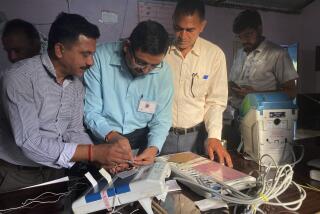PERSPECTIVE ON INDIA : The Post-Colonial Moment Dawns : The election outcome could be the promise of a truly democratic system or a descent into bloody anarchy.
- Share via
The Chandra Shekhar government in India has proved to be a victim of its own irrelevance, but the forthcoming parliamentary and state elections precipitated by its fall raise far more fundamental questions. Will the Indian model of socialist democracy survive? Will the nation hold together, or will it fragment violently into many Balkanized parts? Is the reelection of Rajiv Gandhi the only definite guarantee of a stable future? Can India realize its full potential only as a Hindu state, as the fundamentalists affirm?
These are only a few of the issues Indians will have to contend with as they approach the May elections, arguably the most important since independence in 1947. India’s post-colonial moment has arrived, but the future it holds out is tantalizingly ambiguous, teetering between the promise of a truly representative, federal system and a descent into bloody communal anarchy.
A number of observers have identified the elections as nothing special--business as usual; this is facile and disingenuous. The bitter cynicism with which politics is regarded in India today points to a legitimation crisis that is not merely political but one of national identity. As religious extremists whip up communal passions and dismiss the democratic experience as an unmitigated failure, there is an urgent need to reaffirm democratic principles of liberty and equality that were quite compromised by the rogue politics of the post-colonial era. The May elections are critical, therefore, in that they will determine whether Indians will rescue democracy from the politicians who have compromised it, or submit to the dangerous illusions of a fundamental state.
In this task, they will be faced with three very political visions. At one end of the spectrum is the fascist message of the Hindu right. At the other, the confused ambiguity of the left-wing coalition led by V.P. Singh, still chasing the mirage of a socialism that works. Sandwiched in between is the once-mighty Congress party, reduced to irrelevance by the visionless Rajiv Gandhi, a political chimera banking on the tradition of dubious stability provided by his family.
One of these groups will define India’s political future. The first is downright dangerous. With an exclusionary religio-political message that bastardizes the cosmopolitan Hindu ideal, the fundamentalists are a chilling reminder of India’s legacy of communal violence. The Hindu fundamentalists has offered no redeeming theory of state or citizenship, no vision of representative government save one in which minorities will be tolerated as long as they acquiesce to a second-class status.
As for the other two groups, not much distinguishes Gandhi from Singh. Both claim inheritance from the Indian National Congress, whose design for the country’s future translated into the Nehruvian model of state-administered “socialist democracy”--an amalgam of welfare-state institutions and Soviet-inspired command economic policies--based on the assumption that state power could modernize social existence.
This model’s dramatic expansion of centralized state agencies at the national, regional and local levels created gross deficiencies in public finances and forced arbitrary reductions in crucial areas like agriculture and industry. Moreover, under Indira Gandhi, the preoccupation with political survival at all costs translated into policies that aborted democratic principles in favor of maintaining that sacred cow, “national stability,” often by the repeated use of paramilitary forces.
The practical effect of this was a system synonymous with bureaucratic red tape, inefficiency and corruption. Economically, with a deficit projected at nearly 8.5% of gross domestic product and inflation estimated at 12%, the system faces impending collapse.
India has had democracy in its post-colonial phase, but it has been imperfect. The democratic remedy lies with the one institution of the post-colonial state that has really worked: elections. One alternative might be a Congress party that jettisons its dependence on the Nehru family and its failed endowment of democratic socialism, in favor of a federalist platform. The other would be the leftist coalition of V.P. Singh, who has surprised many Indians with his political resilience, championship of secular principles and personal integrity. Singh, however, would have to divest himself of his albatross: a naive belief in the efficacy of socialist solutions.
The secret of a federal democratic system, whose success requires the maximization of liberty and equality among citizens, is the division of decision-making powers into a variety of institutions within and between the center and the states, and between civil society and the state.
Understood in these terms, democratization in India would mean two interconnected processes: the enhancement of social equality and liberty, and the restructuring and democratizing of state institutions. And there lies the hope: that this federalist direction is the one in which Indian democracy is heading.
The one clear result of the 1991 elections will be the failure of any one party to win an overwhelmingly majority at the central and the state levels. In such a situation, the Indian electorate will have forced the politicians to rediscover the federal alternative to one-party hegemony. The homogeneous post-colonial state will be replaced by a much looser confederation of states and a capitalist economic order that can harness the entrepreneurial potential so evident in India’s parallel economy.
The Nehruvian vision of Indian politics is waning, and with much confusion, but this should not be a signal for reactionary extremism. As Hegel said, heroic endeavors to establish democracy on a large scale sometimes end in disorder and disenchantment, or even in bloody fiasco. And sometimes, they resound in success. In that lies both the peril, and the promise, of the May, 1991, Indian elections.
More to Read
Sign up for Essential California
The most important California stories and recommendations in your inbox every morning.
You may occasionally receive promotional content from the Los Angeles Times.










